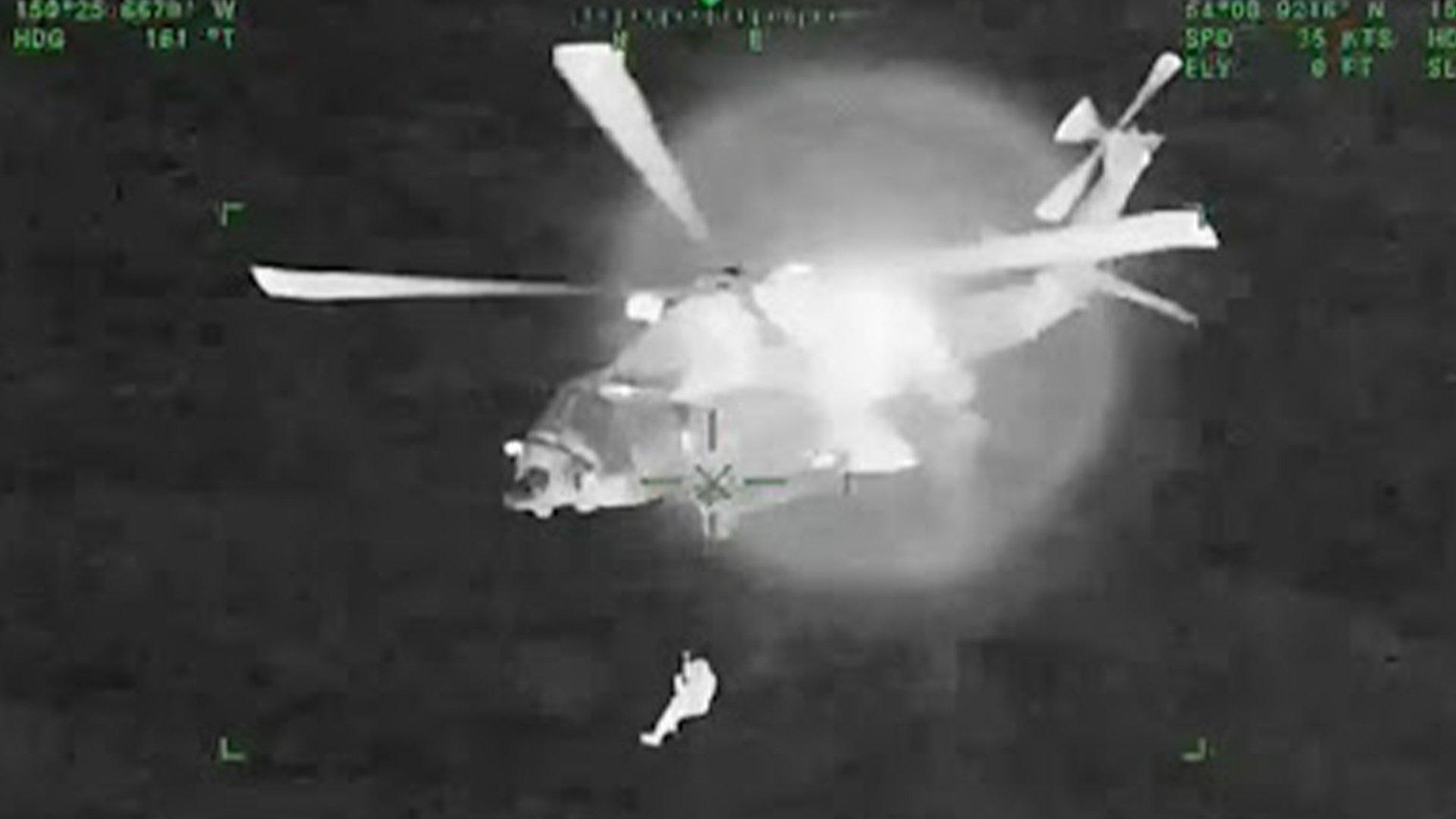
Aviation Survival Technician 2nd Class Tyler Stacey is hoisted up to the US Coast Guard Air Station Kodiak MH-60T Jayhawk on Oct. 4, 2022, more than 200 nautical miles south of Kodiak, Alaska. Screenshot from US Coast Guard video.
When you’re the US Coast Guard rescue crew on duty, and you get the order to fly your helicopter into a black hole, you fly.
“It was in a black hole of areas. There are actually no aeronautical charts loaded,” MH-60T Jayhawk pilot Lt. Robert McConnel told Coffee or Die Magazine.
It was Tuesday, Oct. 4, and McConnel knew only a few things about the mayday mission.
He was supposed to rendezvous with the freighter Palona about 450 nautical miles south of Kodiak Island in the vast Gulf of Alaska, where a sick 41-year-old mariner needed an urgent airlift to a mainland hospital.
They had to get that done in eight hours, or the patient might die.
And McConnel knew that, if he ran out of fuel over the water trying to get to land, his nearest rescuer would be 700 nautical miles away, in either Sitka or Kotzebue, a landing strip above the Arctic Circle.
He began cogitating fuel burn.
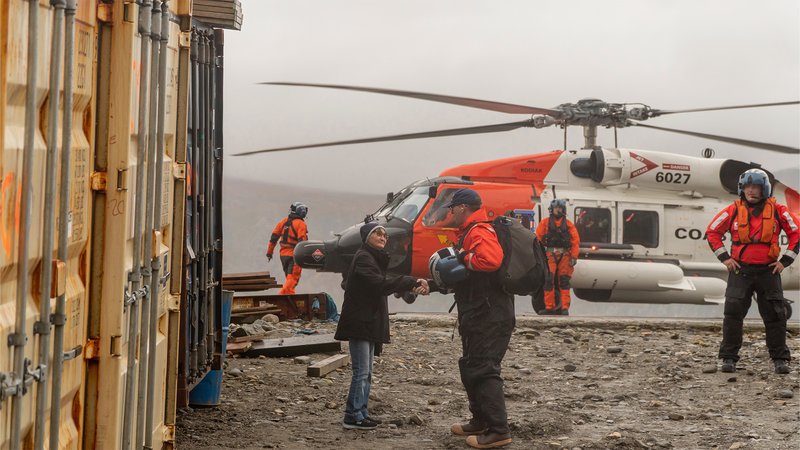
A US Coast Guard Air Station Kodiak MH-60T Jayhawk helicopter crew arrives in Diomede, Alaska, Sept. 21, 2022. US Coast Guard photo by Public Affairs Specialist 3rd Class Tobias Hofmann.
A Jayhawk can fly up to 700 nautical miles without refueling, but that’s not a perfect formula. Cold temperatures, buffeting winds, how high the helicopter would have to climb, and how much gear and crew it carried conspired to lower the range to about 600 miles.
“There's different fuel burn for different speeds of flying,” McConnel, 30, said. “There's different fuel rates for hovering. Essentially, 600 miles is, yeah, you can probably, if you did what we did. Which was, we took gear off the plane that we needed to. We had the minimum crew and we fueled the plane until the plane stopped. It wouldn’t take any more fuel.”
McConnel and his operations boss, Cmdr. Ryan Hawn, 39, figured that the freighter was splashing through the gulf at 14 knots toward Kodiak. If they delayed launching the helicopter until it got to within range of the Jayhawk, they might not be able to lift off the freighter until 10 p.m., which was probably too late to save the patient's life.
They spread their charts in front of them and started running the calculations. After two hours of math, they decided that, if the ship got within 280 nautical miles, they could survive the mission. Probably.

US Coast Guard aircrews routinely rescue sick and injured mariners at sea in the Gulf of Alaska, like this 38-year-old crewman from the Hong Kong-flagged cargo ship Xin Li Hia, who was plucked by a helicopter approximately 230 nautical miles southwest of Dutch Harbor on July 26, 2022. US Coast Guard photo.
At 6:45 p.m., the Marshall Islands-flagged Palona was 285 nautical miles south of Kodiak, “and that’s when we started walking into the plane,” McConnel said.
The crew’s elite rescue swimmer, Aviation Survival Technician 2nd Class Tyler Stacey, 29, asked the flight surgeon for the latest vitals on the mariner, who'd been complaining about abdominal pain.
“We need you to go now. He’s tanking,” Stacey learned.
And the surgeon told him he’d need to push fluids to the patient to keep him stabilized on the trip back, something Stacey wasn’t qualified to do. So McConnel turned to Health Services Technician 2nd Class Bailey Duffell, Air Station Kodiak’s sole medic qualified to ride on the Jayhawk to sea.
It would take him 30 minutes to get there. McConnel now had to burn down fuel to just above 6,100 pounds to take Duffell’s extra weight, which was going to cut the amount of time they could spend in the air. Every minute the medic took to get there was going to hurt the mission, but Duffell wasn’t the kind of man who wasted time.
“So, we’re just sitting there spinning and Bailey was, I guess, I don’t know, a miracle man with how fast he was,” McConnel said. “He was at the plane, in his gear, with all of his IVs and everything, all of his bags, in 18 minutes.”
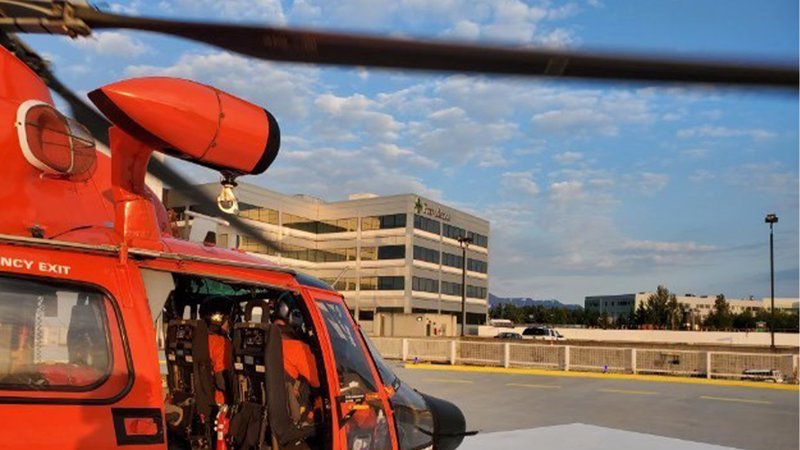
A US Coast Guard Air Station Kodiak helicopter aircrew landed on the roof of the Providence Alaska Medical Center in Anchorage, Alaska, after medically evacuating an injured crew member from the fishing vessel Silver Storm near Esther Island on June 16, 2022. US Coast Guard photo.
To save the crew precious minutes communicating with the Palona, Coast Guard watchstanders scrambled an HC-130J Super Hercules reconnaissance plane and told the crew to rendezvous with the freighter and Jayhawk, which rose into the sky for its journey across the gulf.
But McConnel’s 1,000-foot ceiling quickly dropped to 280 feet. The Jayhawk was at 300 feet, the pilots flying after sundown using their night vision goggles, so they dipped out of soup and choppered just 20 stories above the heaving waves.
McConnel could see a quarter-mile in front of the nose, because of the fog and rain, but then they saw the freighter. Luckily, it was in a patch of good weather.
"But their lights were shining off all the fog so it's super foggy, kind of hard to see,” McConnel said.
The Jayhawk crew reached the boat about 242 nautical miles south of Kodiak. It was 11 p.m., and seas rose and plunged, pitching the Palona.
And 20-knot tailwinds kept slapping at the helicopter.
“It was definitely a little sportier than a normal carrier hoist,” McConnel said.

A patient n board the freighter Palona awaits a medevac by US Coast Guard Air Station Kodiak crew members obn Oct. 4, 2022, in the Gulf of Alaska. Screenshot from US Coast Guard video.
The Jayhawk crew learned the patient couldn’t walk. And he'd started throwing up blood. He needed supplemental oxygen to breathe.
Flight mechanic Avionics Electrical Technician 2nd Class Eddie Farley, 30, began hoisting Stacey down. On the freighter’s deck, the rescue swimmer rushed to strap the sick mariner to the litter, and up they went.
McConnel told Coffee or Die the coordination between Farley and Stacey was perfect. They cut the time spent on the medevac hoist to only 18 minutes.
He nosed the helicopter to 2,000 feet to avoid icing and find calmer winds for the journey back to Kodiak. Within an hour, Duffell and Stacey had stabilized the patient, although he was moving in and out of consciousness.
“This was Bailey’s first case ever in a helicopter,” McConnel said. “I can’t imagine providing care in the back of a vibrating helicopter, especially putting an IV in.”
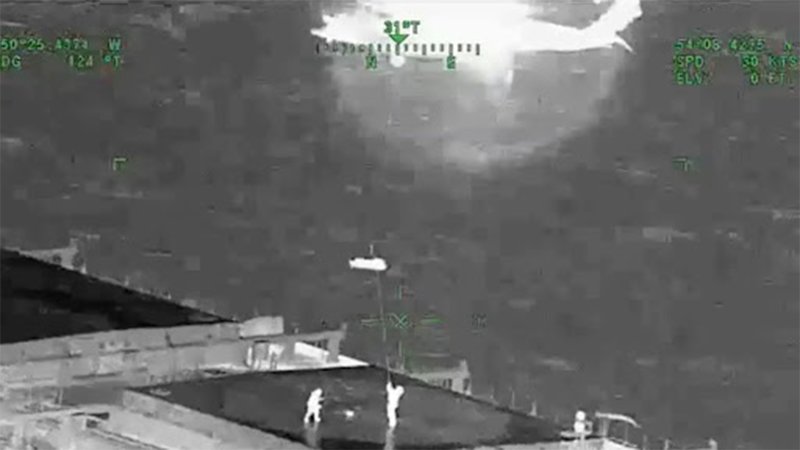
US Coast Guard Aviation Survival Technician 2nd Class Tyler Stacey guides a litter as it is hoisted up to the Air Station Kodiak MH-60T Jayhawk on Oct. 4, 2022, in the Gulf of Alaska. Screenshot from US Coast Guard video.
McConnel and Hawn put the Jayhawk’s wheels down at Kodiak Benny Benson State Airport at 12:53 a.m. on Wednesday. They had 680 pounds of fuel left, probably less than 25 minutes of burn before the engine shut off.
Every second the crew shaved off by good planning, efficient execution, and lucky breaks in the foul weather paid off. They’d made it.
A LifeMed Alaska crew was waiting to fly the patient to the hospital.
“The Coast Guard trains its crews well,” McConnel said. “Kodiak has a unit-specific syllabus to prepare you for these long-range, poor weather cases. Our rescue swimmer, flight mechanic, and health services technician all crushed it. Without Tyler requesting to bring Bailey, without Bailey pushing fluids, or Eddie making up for my poor piloting, I’m fairly confident that this individual would have died.”
Editor's note: A caption in a photo was changed to reflect that the image was taken by Aviation Survival Technician 3rd Class Tobias Hofmann.
Read Next: Scrawled in the Sanibel Island Sand: HELP
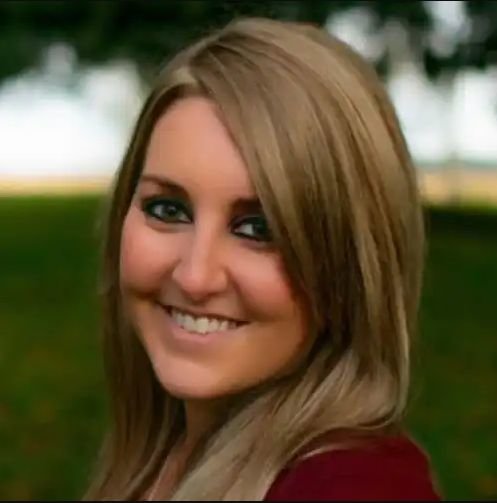
Noelle is a former staff writer for Coffee or Die through a fellowship from Military Veterans in Journalism. She has a bachelor’s degree in journalism and interned with the US Army Cadet Command. Noelle also worked as a civilian journalist covering several units, including the 75th Ranger Regiment on Fort Benning, before she joined the military as a public affairs specialist.
BRCC and Bad Moon Print Press team up for an exclusive, limited-edition T-shirt design!
BRCC partners with Team Room Design for an exclusive T-shirt release!
Thirty Seconds Out has partnered with BRCC for an exclusive shirt design invoking the God of Winter.
Lucas O'Hara of Grizzly Forge has teamed up with BRCC for a badass, exclusive Shirt Club T-shirt design featuring his most popular knife and tiomahawk.
Coffee or Die sits down with one of the graphic designers behind Black Rifle Coffee's signature look and vibe.
Biden will award the Medal of Honor to a Vietnam War Army helicopter pilot who risked his life to save a reconnaissance team from almost certain death.
Ever wonder how much Jack Mandaville would f*ck sh*t up if he went back in time? The American Revolution didn't even see him coming.
A nearly 200-year-old West Point time capsule that at first appeared to yield little more than dust contains hidden treasure, the US Military Academy said.












